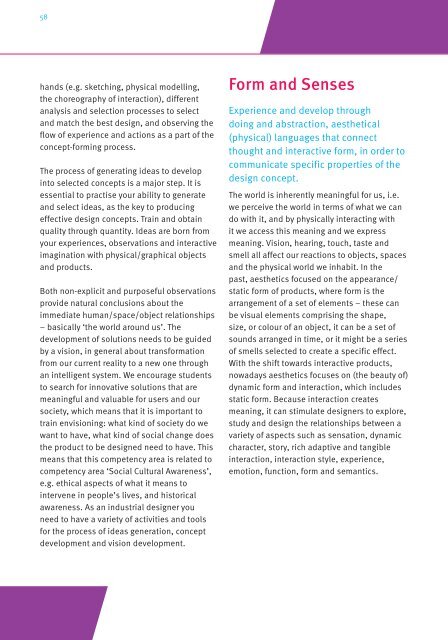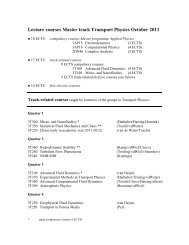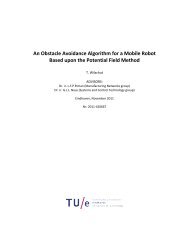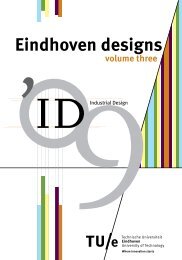Education guide 'Eindhoven designs' - Technische Universiteit ...
Education guide 'Eindhoven designs' - Technische Universiteit ...
Education guide 'Eindhoven designs' - Technische Universiteit ...
Create successful ePaper yourself
Turn your PDF publications into a flip-book with our unique Google optimized e-Paper software.
58<br />
hands (e.g. sketching, physical modelling,<br />
the choreography of interaction), different<br />
analysis and selection processes to select<br />
and match the best design, and observing the<br />
flow of experience and actions as a part of the<br />
concept-forming process.<br />
The process of generating ideas to develop<br />
into selected concepts is a major step. It is<br />
essential to practise your ability to generate<br />
and select ideas, as the key to producing<br />
effective design concepts. Train and obtain<br />
quality through quantity. Ideas are born from<br />
your experiences, observations and interactive<br />
imagination with physical/graphical objects<br />
and products.<br />
Both non-explicit and purposeful observations<br />
provide natural conclusions about the<br />
immediate human/space/object relationships<br />
– basically ‘the world around us’. The<br />
development of solutions needs to be <strong>guide</strong>d<br />
by a vision, in general about transformation<br />
from our current reality to a new one through<br />
an intelligent system. We encourage students<br />
to search for innovative solutions that are<br />
meaningful and valuable for users and our<br />
society, which means that it is important to<br />
train envisioning: what kind of society do we<br />
want to have, what kind of social change does<br />
the product to be designed need to have. This<br />
means that this competency area is related to<br />
competency area ‘Social Cultural Awareness’,<br />
e.g. ethical aspects of what it means to<br />
intervene in people’s lives, and historical<br />
awareness. As an industrial designer you<br />
need to have a variety of activities and tools<br />
for the process of ideas generation, concept<br />
development and vision development.<br />
Form and Senses<br />
Experience and develop through<br />
doing and abstraction, aesthetical<br />
(physical) languages that connect<br />
thought and interactive form, in order to<br />
communicate specific properties of the<br />
design concept.<br />
The world is inherently meaningful for us, i.e.<br />
we perceive the world in terms of what we can<br />
do with it, and by physically interacting with<br />
it we access this meaning and we express<br />
meaning. Vision, hearing, touch, taste and<br />
smell all affect our reactions to objects, spaces<br />
and the physical world we inhabit. In the<br />
past, aesthetics focused on the appearance/<br />
static form of products, where form is the<br />
arrangement of a set of elements – these can<br />
be visual elements comprising the shape,<br />
size, or colour of an object, it can be a set of<br />
sounds arranged in time, or it might be a series<br />
of smells selected to create a specific effect.<br />
With the shift towards interactive products,<br />
nowadays aesthetics focuses on (the beauty of)<br />
dynamic form and interaction, which includes<br />
static form. Because interaction creates<br />
meaning, it can stimulate designers to explore,<br />
study and design the relationships between a<br />
variety of aspects such as sensation, dynamic<br />
character, story, rich adaptive and tangible<br />
interaction, interaction style, experience,<br />
emotion, function, form and semantics.

















